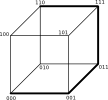- Eye Pattern

In telecommunication, an eye pattern, also known as an eye diagram, is an oscilloscope display in which a digital data signal from a receiver is repetitively sampled and applied to the vertical input, while the data rate is used to trigger the horizontal sweep. It is so called because, for several types of coding, the pattern looks like a series of eyes between a pair of rails.
- Russian Woodpecker
The Russian Woodpecker was a notorious Soviet signal that could be heard on the shortwave radio bands worldwide between July 1976 and December 1989. It sounded like a sharp, repetitive tapping noise, at 10 Hz, giving rise to the “Woodpecker” name. The random frequency hops disrupted legitimate broadcast, amateur radio, utility transmissions, and resulted in thousands of complaints by many countries worldwide. The signal was long believed to be that of an over-the-horizon radar (OTH) system.
- Heron’s Fountain

Heron’s fountain is a hydraulic machine invented by the first century inventor, mathematician, and physicist Heron, also known as Hero of Alexandria. Heron studied the pressure of air and steam, described the first steam engine, and built toys that would spurt water, one of them known as Heron’s fountain.
- Involuntary Park
Involuntary park is a neologism coined by science fiction author and environmentalist Bruce Sterling to describe previously inhabited areas that for environmental, economic or political reasons have, in Sterling’s words, “lost their value for technological instrumentalism” and been allowed to return to an overgrown, feral state.
- Snake-in-the-Box

The snake-in-the-box problem in graph theory and computer science deals with finding a certain kind of path along the edges of a hypercube. This path starts at one corner and travels along the edges to as many corners as it can reach. After it gets to a new corner, the previous corner and all of its neighbors must be marked as unusable. The path should never travel to a corner after it has been marked unusable.







“1. Cut a hole in the box.
2. Put your snake-in-the-Box.
3. Make her open the box.
That’s the way you do it.
Snake-in-the-Box.”